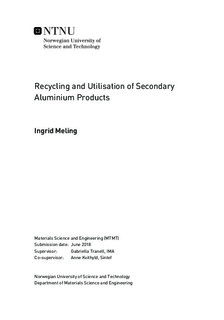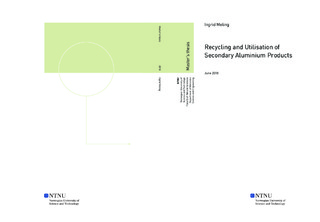| dc.description.abstract | Efficient utilisation of secondary aluminium products is increasingly important as the energy
consumption and CO2 emissions are greatly reduced by recycling compared to primary
production. The aim of this study was to compare the recyclability of used beverage cans
to incinerator metal, and investigate the efficiency of an environmentally friendly salt flux.
In addition, an alternative to traditional recycling was executed to potentially increase the
utilisation of dross.
Used beverage can scrap and incinerator metalwere melted under two different salt fluxes in
two different induction furnaces one 20 cl. crucible and one 500 cl. crucible. For the smallscale
experiments the coalescence was measured by sieving the resulting metal pieces. In
the larger scale experiments, the yield was measured through a mass balance and the metal
was analysed through inductively coupled plasma mass spectrometry and electron probe
analyser.
Furthermore, clean aluminium and dross were charged into a pre-prepared molten CaOSiO2
slag at 1600±C for the purpose of aluminothermic reduction of SiO2. The resulting metal
and slag phases were chemically analysed by inductively coupled plasma mass spectrometry
and electron probe analyser, and compared to results obtained by thermodynamic modelling.
The results indicate that the incinerator metal is highly recyclable, as it is easily coalesced
and produce yields in the same region as used beverage cans. However, lead contaminations
are present in the raw material leading to relatively high lead contents in the resulting metal,
which could be detrimental for the finished product.
As for the salts, the operating temperature seems to be of importance for their performance.
Temperatures close to the salts solidification temperature result in low yield, which is also
confirmed by theory. In the small-scale experiments, the recycled salt seemed to perform
very well, while the two salts performapproximately equal in the larger scale experiments.
Moreover, from the preliminary experiments on aluminothermic reduction, dross seems like
a suitable reducing material for aluminothermic reduction, as the chemical composition is
very close to that obtained for clean aluminium. However, the obtained chemical compositions
deviate from the theoretical composition, most likely due to the solidification procedure. | |

